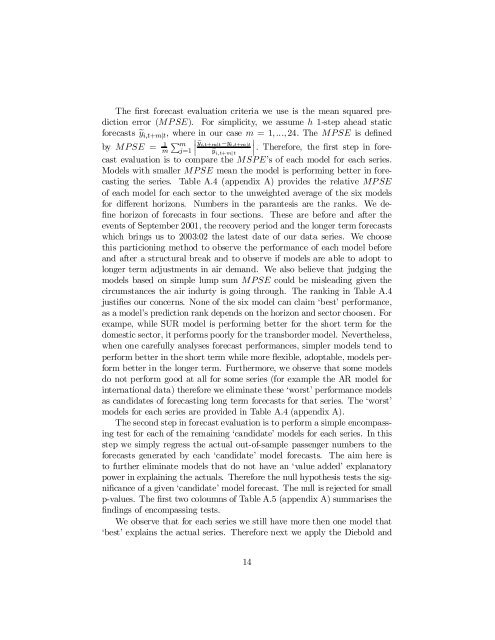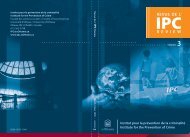0306E - Faculty of Social Sciences - Université d'Ottawa
0306E - Faculty of Social Sciences - Université d'Ottawa
0306E - Faculty of Social Sciences - Université d'Ottawa
Create successful ePaper yourself
Turn your PDF publications into a flip-book with our unique Google optimized e-Paper software.
The …rst forecast evaluation criteria we use is the mean squared prediction<br />
error (MP SE). For simplicity, we assume h 1-step ahead static<br />
forecasts ey i;t+mjt ; where in our case m = 1; :::; 24: The MPSE is de…ned<br />
by MPSE =<br />
m 1 P mj=1 ey<br />
¯¯¯<br />
i;t+mjt ¡y i;t+mjt<br />
ey i;t+mjt<br />
¯¯¯ : Therefore, the …rst step in forecast<br />
evaluation is to compare the MSPE’s <strong>of</strong> each model for each series.<br />
Models with smaller MPSE mean the model is performing better in forecasting<br />
the series. Table A.4 (appendix A) provides the relative MP SE<br />
<strong>of</strong> each model for each sector to the unweighted average <strong>of</strong> the six models<br />
for di¤erent horizons. Numbers in the parantesis are the ranks. We de-<br />
…ne horizon <strong>of</strong> forecasts in four sections. These are before and after the<br />
events <strong>of</strong> September 2001, the recovery period and the longer term forecasts<br />
which brings us to 2003:02 the latest date <strong>of</strong> our data series. We choose<br />
this particioning method to observe the performance <strong>of</strong> each model before<br />
and after a structural break and to observe if models are able to adopt to<br />
longer term adjustments in air demand. We also believe that judging the<br />
models based on simple lump sum MPSE could be misleading given the<br />
circumstances the air indurty is going through. The ranking in Table A.4<br />
justi…es our concerns. None <strong>of</strong> the six model can claim ‘best’ performance,<br />
as a model’s prediction rank depends on the horizon and sector choosen. For<br />
exampe, while SUR model is performing better for the short term for the<br />
domestic sector, it performs poorly for the transborder model. Nevertheless,<br />
when one carefully analyses forecast performances, simpler models tend to<br />
perform better in the short term while more ‡exible, adoptable, models perform<br />
better in the longer term. Furthermore, we observe that some models<br />
do not perform good at all for some series (for example the AR model for<br />
international data) therefore we eliminate these ‘worst’ performance models<br />
as candidates <strong>of</strong> forecasting long term forecasts for that series. The ‘worst’<br />
models for each series are provided in Table A.4 (appendix A).<br />
The second step in forecast evaluation is to perform a simple encompassing<br />
test for each <strong>of</strong> the remaining ‘candidate’ models for each series. In this<br />
step we simply regress the actual out-<strong>of</strong>-sample passenger numbers to the<br />
forecasts generated by each ‘candidate’ model forecasts. The aim here is<br />
to further eliminate models that do not have an ‘value added’ explanatory<br />
power in explaining the actuals. Therefore the null hypothesis tests the signi…cance<br />
<strong>of</strong> a given ‘candidate’ model forecast. The null is rejected for small<br />
p-values. The …rst two coloumns <strong>of</strong> Table A.5 (appendix A) summarises the<br />
…ndings <strong>of</strong> encompassing tests.<br />
We observe that for each series we still have more then one model that<br />
‘best’ explains the actual series. Therefore next we apply the Diebold and<br />
14
















